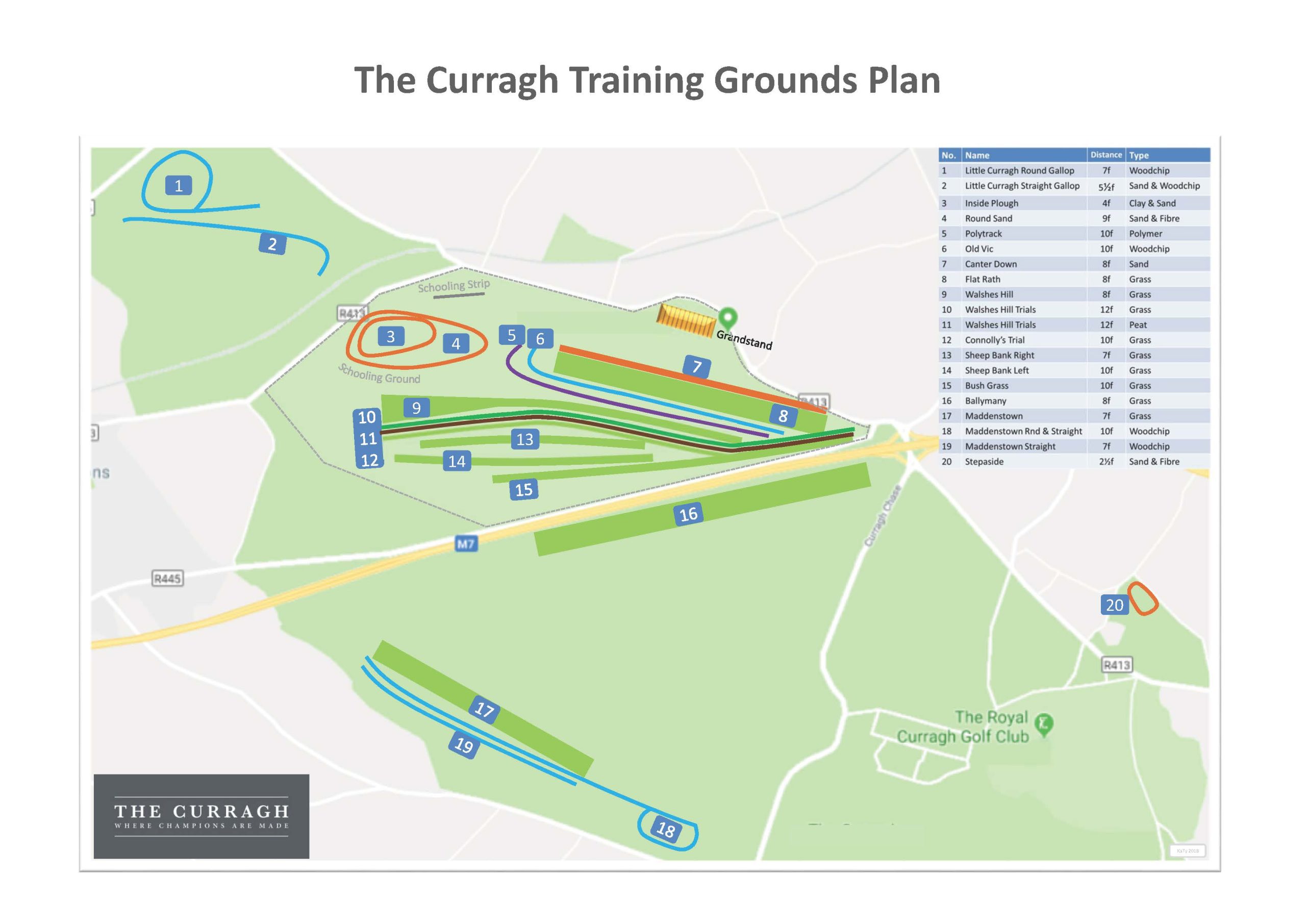Summary
In addition to the Racecourse, the Curragh is also home to the Training Grounds which contains 80 miles of gallops over 1,500 acres.
The natural turf gallops which have been nurtured for centuries in a unique environment are complemented by a range of artificial surfaces which can be used for all types of work during all seasons. The range of gallops provides trainers with great scope to tailor each horse’s work to suit their individual needs, with gallops varying in length, gradient and surface.
To ensure that National Hunt trainers are well catered for, the training grounds have an all-weather schooling strip as well as extensive schooling options over both hurdles and fences on grass.
The Curragh is home to over fifty trainers based in close proximity to the gallops to avail of the excellent facilities. The Curragh Training Grounds are maintained and operated 365 days a year by a skilled and dedicated team providing trainers with continuity and peace of mind even during extreme weather conditions.
Grass gallops
The Curragh grass gallops are the foundation of the training grounds and are rotated throughout the year in order to provide fresh ground throughout the season. Walsh’s Hill opens each March and has a variety of canters, grass, trial and peat gallops. They range from 8-12 furlongs and are where horses like Sea the Stars and Harzand did their main work. The Flat Rath grass gallops open each May and run for a mile in front of the racecourse stands. The Bush gallop provides a stiff test for national hunt horses and is in high demand during the winter months.
Walsh’s Hill
Walsh’s Hill is named after the Walsh family, who owned a property there and gave their name to the highest point on the Curragh Training Grounds. It is reported that Pat Connolly held the first public training licence in Ireland. He purchased a site from a family named Walsh and built Curragh View Stables.

Maddenstown and Little Curragh
Maddenstown and the Little Curragh provide the boundaries on either side of the Curragh. Both of these facilities are steeped in history and have been home to many Group 1 winners. The facilities on offer in Maddenstown and the Little Curragh allow trainers to do their daily work on these gallops with the option of using the racecourse side when they wish to change a horse’s routine.

Little Curragh
The Little Curragh was home to one of the best racehorses we have ever seen in Sea the Stars and more recently the consistent Group 1 performer Romanised. The Little Curragh offers a 7-furlong round woodchip gallop with a shoot as well as a 5 ½-furlong sand and fibre straight gallop.
Schooling Facilities
To ensure that National Hunt trainers are well catered for, the training grounds have an all-weather schooling strip as well as extensive schooling options over both hurdles and fences on grass. The Round Sand is a 9 Furlong round circuit used for cantering flat and national hunt horses. The Round Sand provides the strongest test of the all-weather gallops available on the Curragh and therefore is widely used for fast work by national hunt trainers.

Schooling Facilities
Year in, year out the Curragh produces a number of top-class national hunt performers. The roll of honour is endless but includes champions such as Hardy Eustace, Our Conor, Like a Butterfly, Papillion, Comanche Court, Numbersixvalverde and most recently Cheltenham festival winner City Island. Top national hunt trainers from all over the country also visit the facility to school every Tuesday and Friday.

| Schooling Hurdles
Opened Tuesdays and Fridays |
Schooling Fences
Opened Tuesdays and Fridays |
Schooling Strip
Opened Monday to Saturday |
| The Curragh Training Grounds provide a number of hurdles options during the season. There is a mixture of regular and easy fix hurdles while the new padded hurdles are also available. The round circuit with 8 hurdles provides a racetrack experience and is extremely popular as it creates a racecourse experience. | A strip of 3 fences are available on grass. Additional Grand National style fences are dressed by Aintree twice a year to school over before the Beecher Chase and Grand National to provide experience for Irish horses in preparation for a trip to Liverpool. | The all-weather schooling strip is open Monday to Saturday all year. It provides a safe option during the summer months when the ground may be too quick to school on grass. |
The Old Vic
The Old Vic, a 9 Furlong Woodchip gallop, originally commissioned by his Highness Sheikh Mohammed bin Rashid Al Maktoum and named after his 1989 Irish Derby winner, runs in front of the racecourse stands and climbs steadily for a mile and a furlong. It is the Curraghs flagship gallop for fast work and is used in the preparation for the big race day.
The Free Eagle
This new 9-furlong sand and fibre gallop made possible due to the generous support of Eva Maria Bucher-Haefner is a huge addition to the training grounds. The uphill gallop that runs alongside the Old Vic is named after Moyglare Studs Group 1 winner Free Eagle who himself used the Curragh facilities every day of his racing career. This gallop has all the attributes of the Old Vic but provides an alternative option for trainers to exercise a horse on a slower sand and fibre surface instead of woodchip.
The Round Sand
The Round Sand is a 9 Furlong round circuit used for cantering flat and national hunt horses. The Round Sand provides the strongest test of the all-weather gallops available on the Curragh and therefore is widely used for fast work by national hunt and point to point trainers. This gallop has been used in the preparation of countless Cheltenham festival winners.
